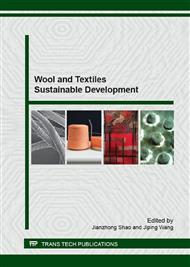[1]
B. Mehdi, O. Erfan, S. Hadi, H. Hengameh, Preparation and application of chitin and its derivatives: a review, Iran. Polym. J. 23(2014): 307–326.
Google Scholar
[2]
V. N. Puthiya, G. Rajan, T. R. Srikrishnaperumal, Degradation of dyes from aqueous solution by Fenton processes: a review, Environ. Sci. Pollut. Res. 20(2013): 2099–2132.
DOI: 10.1007/s11356-012-1385-z
Google Scholar
[3]
B. Arjunan, M. Karuppan, A review on Fenton and improvements to the Fenton process for wastewater treatment, Journal of Environmental Chemical Engineering. 2 (2014): 557–572.
DOI: 10.1016/j.jece.2013.10.011
Google Scholar
[4]
C. Shamik , B. Rajasekhar, Graphene/semiconductor nanocomposites (GSNs) for heterogeneous photocatalytic decolorization of wastewaters contaminated with synthetic dyes: A review, Applied Catalysis B: Environmental. 160(2014): 307–324.
DOI: 10.1016/j.apcatb.2014.05.035
Google Scholar
[5]
W. L. Chin, C. J. Joon, B. K. Weon, B. A. H. Sharifah. An Overview: Recent Development of Titanium Oxide Nanotubes as Photocatalyst for Dye Degradation, International Journal of Photoenergy. 1(2014): 1-14.
Google Scholar
[6]
S. Ignasi, B. Enric, A. O. Mehmet, A. R. Manuel, P. Marco, Electrochemical advanced oxidation processes: today and tomorrow. A review, Environ. Sci. Pollut. Res. 21(2014): 8336–8367.
DOI: 10.1007/s11356-014-2783-1
Google Scholar
[7]
L. Levin, E. Melignani, A. M. Ramos, Effect of nitrogen sources and vitamins on ligninolytic enzyme production by some white-rot fungi. Dye decolorization by selected culture filtrates, Bioresource technology. 101(2010): 4554-4563.
DOI: 10.1016/j.biortech.2010.01.102
Google Scholar
[8]
C. C. Laura,S. M. José-Luis,E. B. H. Blanca, Biodegradation of organic pollutants in saline wastewater by halophilic microorganisms: a review, Environ. Sci. Pollut. Res. 21(2014): 9578–9588.
DOI: 10.1007/s11356-014-3036-z
Google Scholar
[9]
E. Grassi, P. Scodeller, N. Filiel, Potential of Trametes trogii culture fluids and its purified laccase for the decolorization of different types of recalcitrant dyes without the addition of redox mediators, International Biodeterioration & Biodegradation. 65(2011).
DOI: 10.1016/j.ibiod.2011.03.007
Google Scholar
[10]
I. Ciullini, A. Gullotto, S. Tilli, Enzymatic decolorization of spent textile dyeing baths composed by mixtures of synthetic dyes and additives, Applied Microbiology and Biotechnology. 1(2012): 1-11.
DOI: 10.1007/s00253-011-3809-y
Google Scholar
[11]
Y. Jiang, R. L. Widger, G. D. Kasper, M.A. Siegler, D. P. Goldberg, Iron(II)-Thiolate S-Oxygenation by O2: Synthetic Models of Cysteine Dioxygenase, J. Am. Chem. Soc. 132(2010): 12214-12215.
DOI: 10.1021/ja105591q
Google Scholar
[12]
S. A. Stoian, G. Xue, E. L. Bominaar, L. Jr. Que, E. Münck, Spectroscopic and Theoretical Investigation of a Complex with a [O=FeIV-O-FeIV=O] Core Related to Methane Monooxygenase Intermediate Q, J. Am. Chem. Soc. 136(2014): 1545-1558.
DOI: 10.1021/ja411376u
Google Scholar
[13]
O. V. Makhlynets, N. O. Williamson, Y.S. Moroza, I. G. Belayaa, T. D. Palluccio, A. S. Filatov, P. Müller, M. A. Cranswick, L. J. Que, E. V. Rybak-Akimova, H2O2 Activation with Biomimetic Non-heme Iron Complexes and AcOH: Connecting the g = 2. 7 EPR Signal with a Visible Chromophore, Chem. Commun. 50(2014).
DOI: 10.1039/c3cc47632d
Google Scholar
[14]
M. Louloudi, K. Mitopoulou, E. Evaggelou, Homogeneous and heterogenized copper(II) complexes as catechol oxidation catalysts, J. Mole. Cata. A. 198(2003): 231-240.
DOI: 10.1016/s1381-1169(02)00692-1
Google Scholar
[15]
P. Mallayan, V. Kusalendiran. Mononuclear non-heme Iron (III) of linear and tripodal tridentate ligands as functional models for catechol dioxygenase: effect of N-alkyl substitution on regioselectivity and reaction rate, J. Chem. Sci. 123(2011).
DOI: 10.1007/s12039-011-0110-7
Google Scholar


